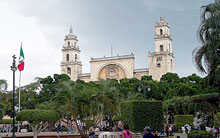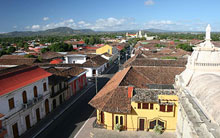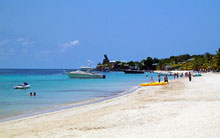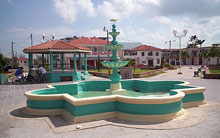The Stock Market Shocker of 2011
Plus 5 More Surprising Predictions By Dick Young
I hate to be the bearer of bad news, but all my indicators are telling me the worst is still ahead of us! The slow-motion decline of U.S. stocks in May is just the beginning. Scared of what will happen to your portfolio if the worst happens (hint: think DOW 6,000 or lower)? If your answer is “No,” you should be ashamed! Market volatility is accelerating, so there is real urgency to preparing NOW. My name is Dick Young, and my job is to think the unthinkable. And prepare subscribers, friends and family accordingly. My job for the past 40 years, without excuses, has been to win. In 2011 the key to my victory plan is to first and foremost make sure I don’t lose. It’s a strategy that has worked spectacularly well for over four decades. What’s your strategy? If you learn nothing else from this letter, remember this warning: The light you see at the end of the tunnel
just may be an oncoming train. Yes, the Dow Jones Industries are still holding above 12,000, and earnings are strong in some industries. But the new bull market is not here, and we are in for anything but a slow and steady march higher. Just beneath the surface, the rot in this market runs deep. Gold is high and about to go MUCH higher, the euro is collapsing, budget deficits are soaring, municipal defaults are looming, employment is stagnating and real estate is spiraling downward. All the warning signs are flashing red; all you have to do is open your eyes to see them. Anyone who is ignoring those signs will get slaughtered AGAIN. I can tell you my eyes are wide open… what about you? Put simply, this is the fundamentally worst, and most dangerous, stock market I have seen since my early days as an investment analyst in the 1970s, a period of unprecedented political unrest, high unemployment, weak U.S. political leadership and gas-line induced oil shortages. If you thought 2008 was a tough year, let me tell you, 2011 may very well make 2008 look like a walk in the park, with DOW 6,000 (or worse!) a very real possibility.
How fast you recognize that, and react accordingly, may very well be the difference between not only surviving, but actually thriving through the coming Great Panic of 2011 or a complete financial wipeout for you and your loved ones. If this sounds scary to you, feel free to put your head back in the sand and take what’s coming your way… but if you’re like me, and absolutely refuse to lose, and are prepared to do the work it takes to be on the winning side of things… then please spend a few minutes reading my full 2011 Forecast Issue. Trust me, it may be the most important few minutes of your investing life. 2011 Shocker #1:
The complete collapse of the European Union This one is unavoidable. The desperation measures the EU countries are taking right now are just more money down the rathole. Think about it: Why should Northern Europe bail out their Southern neighbors for their corruption, wastefulness and fiscal profligacy? When the bill gets to be too high, they won’t. And that’s when the European Union will unravel-faster than anyone thinks possible. As sudden as the collapse of the Berlin Wall, even. Many solid companies that traded in euros will weather this storm, but not before taking a nasty 20%-40% nosedive. I won’t own a single one of them. I’m not waiting for disaster to strike, and neither should you. Join me instead in stocks headquartered in the country with the world’s strongest currency-a source of great competitive advantage in the years ahead. Steer clear of eurozone countries and invest in two great Swiss companies, and lock in 25%-50% profits in the coming year. Switzerland never joined the Euro movement and still possesses the strongest currency in the entire world. In last year’s ranking of Global Competitiveness, Switzerland was #1, a testament to the benefits of conservative management, sound money and no-nonsense regulation of the financial sector. The two companies I’m buying are perfect for the conservative investor looking to profit from the coming European crackup. The first is an innovative seed company perfectly positioned to profit from the worldwide strain on food supplies caused by the global economic recovery. The stock is up 467% in the last 10 years, and it still has years of growth ahead of it. The second is a well-known consumer products giant, selling everything from cereal, baby food, ice cream, chocolate, pet foods and beverages to pet foods. 87% profits in the stock over the last 5 years tells me that the smart money is already on to this story. You should be, too.
2011 Shocker #2:
Major U.S. cities declare bankruptcy Here’s a recipe for fiscal disaster: Combine one part slow recovery from a bad recession, one part overgenerous promises to public employee unions, and one part reluctance to cut the fat that exists in every large workforce. What do you have? Bankrupt cities and states all across America. And painful haircuts for municipal bondholders across the spectrum. Despite the happy talk about how no state has ever gone bankrupt, the numbers are too large, and the politicians too weak, to prevent the worst: - California is cutting back on everything from redevelopment grants to employee cellphones to vehicle fleets…all of which will barely make a dent in a projected annual $20 billion deficit for the next 5 years
- New York’s cumulative budget deficit could reach $50 billion as soon as 2012
- Illinois is already paying vendors with IOUs and just passed a massive tax hike to make its books balance this year, and they aren’t anywhere close to being out of the woods
- Pennsylvania’s state capital, Harrisburg, is teetering on the edge of bankruptcy, thanks mostly to a single disastrous incinerator project
It’s ugly, and only getting uglier. Taxpayers and businesses that can move to avoid the tax increases and service cuts coming down the pike are fleeing in droves. This situation will only get worse for death-spiral locations and the meltdown could devastate your municipal bonds. Our strategy: Avoid the contagion by selling ALL municipal bonds. Buy corporate bonds instead, and only as I direct you.
In over 40 years of investing for myself and clients, I know how shocking it is to see your “safe” assets decline even a little, much less the 20%-40% haircut that is in store for many municipal bond owners.
Don’t be caught owning toxic or worthless assets-shift your money from munis to the bonds on my recommended list immediately. You’ll thank me a thousand times over when the stuff hits the fan. .
2011 Shocker #3:
Middle Eastern unrest leads to $100 a barrel oil,
with $200 a barrel in play The riots and demonstrations roiling the Middle East are a vivid reminder that we’re walking a razor’s edge when it comes to our energy supplies. With “days of rage” planned in Saudi Arabia, Iraq, and every major oil producer in the Middle East, Libya’s supplies constrained by a bloody civil war, and Iran shaking up their leadership ranks, oil is not going to get cheaper any time soon, and could get MUCH more expensive. $200 a barrel is not out of the question, especially if Saudi Arabia falls apart. Recently, the Saudis offered up a fast $35 billion package of new spending to try to calm down their underemployed and disgruntled citizens, but it may not be enough. If it isn’t, and there are supply disruptions from Saudi Arabia, you’re going to see $125 a barrel oil in the blink of an eye. $150 comes shortly after that, and $200 oil is very much in the cards. I’m not trying to make a sensational prediction here. I’m just following events to their logical conclusion, and investing to make the most of a bad situation.
Ten years after 9/11, I still can’t believe that we aren’t exploiting the treasure trove of oil, gas and coal sources here at home rather than relying on Middle Eastern kleptocrats who will never cut us a break. Or worse, autocrats who are despised by their own citizens.When you join Intelligence Report, you’ll get a breakdown of the best energy investments here in the good old U.S. of A. and Canada, too. In fact, my top pick right now is a Canadian natural gas producer with big operations in major U.S. gas fields like the Barnett and Haynesville Shales. The stock hasn’t started to move yet, but it will. Get a nice 2.5% yield to keep you company while you wait.
2011 Shocker #4:
The credit bubble is only going to get bigger. The #1 lie being floated right now is that deflation is a realistic threat to your wealth. No chance! Here’s why: With deflation, Washington would have to pay off all its debts with more expensive dollars in the future. That could double or triple our interest payments, explode the annual deficit past $2 trillion a year, and bring the entire global financial system to its knees. So forget about deflation. Ben Bernanke and the Federal Reserve will pull out all the stops to prevent that from happening. Nope, inflation will rule the day because the only way to treat a gaping fiscal wound like ours is to repay our debts with cheaper dollars. As a side benefit, inflation pumps up housing, the stock market and commodities, too. And that means inflation is baked in the cake-sudden and debilitating and coming much sooner than you think. Don’t believe me? Consider this: Over 60% of all the outstanding U.S. debt will mature over the next three years! With this mountain of debt to be rolled over, do you seriously think our buddy Ben Bernanke is going to want to refinance that debt at higher rates? No way, Jose. Bernanke has already tipped his hand with his “Quantitative Easing 2,” or QE2 plan. More like “Titanic 2,” if you ask me. This plan is just a fancy phrase for printing more money, and it is guaranteed to take bond investors to the woodshed. Inflation will devastate holders of bonds and other fixed-income assets. That only includes every retiree, every major pension fund, and all the kind foreigners who have been buying our debt since Uncle Sam decided to go on tilt on the national credit card. Never forget that the bond market is 3 times larger than the stock market. Big inflation is going to hurt-a lot. How do you protect yourself? Gold (and select foreign currencies) is the best way to profit from runaway inflation and a crippled U.S. dollar. As the U.S. dollar goes down-and it must, thanks to the easy money policies of the Obama administration and the Bernanke Fed-gold only gets more valuable. That goes double for the strongest foreign currencies-investors will flee to them rather than see their purchasing power eroded as surely as a sand castle at high tide.
Hint: We don’t buy individual miners or (God help us) junior exploration companies. You might as well just light a match to your money-big capital costs, environmental problems, labor strikes, one bad accident-the risks are just too high. We own rock-solid mutual funds and ETFs instead. Remember, we study risk first, and reward last. So we’re going to give up the gamble for a home run in a mining company that may just hit the jackpot. That same company could also go bankrupt in the twinkle of an eye. So we diversify to lock in the upside and shrink the downside to a microscopic level. 2011 Shocker #5:
Despite being the worst president in history,
Obama might actually get re-elected. Let me be clear—I do NOT want to see this happen. But the Fed’s policy of printing money is going to guarantee three things:The economy is going to get better - Stocks will go up
- Bonds will go down
Although I think it would be a horrendous mistake, Obama has a clear path to another term ahead of him unless the Republicans can come up with a credible, attractive alternative.Remember, Washington has an enormous sway over your personal financial situation. If Republicans hadn’t taken over the House last November, do you think there’s even a prayer the Bush tax cuts would have been extended? Fat chance. The prospect of another four years of President Obama is not a pleasant thought. 2011 Shocker #6:
China, and other Nightmare Scenarios China is on the move, and the direction is not good. A new stealth jet fighter? Check. A near monopoly on rare-earth minerals? Check. Open oppression of a Nobel Peace Prize winner and his family? Double Check. Pay no attention to the smoke-and-mirrors act Hu Jintao presented at his official state visit in January. China is a giant house of cards that will come tumbling down sooner, not later. When the China bubble bursts, too many investors will wonder how they got suckered again. - Why did they believe the Chinese government’s statistics?
- How could they have trusted their money to flimsy China IPOs?
- Why didn’t they pay more attention to the troubling reality behind the shiny bullet trains and Olympic triumphs?
Don’t be one of the suckers. If you listen to me on nothing else, heed my call on this: Do not invest a penny in China stocks. After China, two other things keep me up at night: Mexico and EMPs. Mexico is—for all intents and purposes—a state run by narco-kingpins. The rot runs deep, and corruption infects every layer of government. You won’t ever see me recommend a Mexican stock for purchase, or a Mexican destination for a vacation, for that matter. And don’t get me started on EMPs. An electromagnetic pulse is released when a nuclear weapon is detonated in the atmosphere, and it is devastating to all the things we take for granted. A small nuke detonated over the Eastern seaboard could wipe out electricity, communications and power supplies for nearly the whole length of the Atlantic coastline. With this threat growing due to the proliferation of the North Koreans and Pakistanis, not to mention the efforts of the Iranians to acquire nukes, there is one obvious move: Buy defense stocks. The world is a dangerous place and it’s only getting more so. I’m putting my trust in one of America’s most advanced defense companies, maker of aircraft, missiles, guidance systems, space technology and all manner of goodies to keep the bad guys off guard. Sporting a 3.7% yield and rising faster than all its big defense peers, I can’t fathom why it’s only selling for 11 times earnings. And it’s already up 14% so far in 2011. Grab your share now, before the unthinkable happens.
Red flags are not just being raised—they are being waved furiously to get your attention. 2010’s meager profits are going to look pretty attractive when compared to the carnage ahead. It’s your move. You don’t have another minute to waste. The stock market is crumbling, enemies of your wealth are multiplying. Dividends and risk control are the keys. Not some algorithm, trading system or crystal ball.
Richard C. Young
Young’s Intelligence Report
Disclaimer: The opinions expressed, contents included and photographs presented herein are of and by the originating authors. They reserved all rights and ownership of said article. It is republished here for the sole enjoyment and convenience of our readers who chose to visit this site by voluntarily clicking the link and viewing it. Warning: Information contained above, while believed to be correct, is not guaranteed as accurate.
| 
































 In recent weeks, government bond yields for the PIIGS have blown out to new highs as bond prices have plunged.
In recent weeks, government bond yields for the PIIGS have blown out to new highs as bond prices have plunged. 
